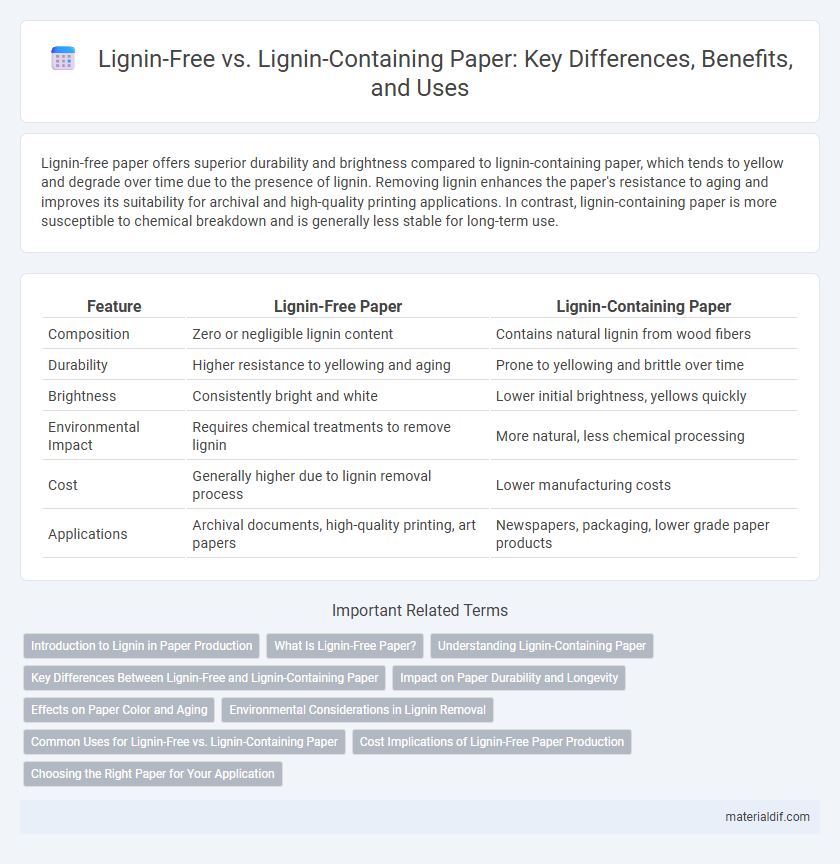Lignin-free paper offers superior durability and brightness compared to lignin-containing paper, which tends to yellow and degrade over time due to the presence of lignin. Removing lignin enhances the paper's resistance to aging and improves its suitability for archival and high-quality printing applications. In contrast, lignin-containing paper is more susceptible to chemical breakdown and is generally less stable for long-term use.
Table of Comparison
| Feature | Lignin-Free Paper | Lignin-Containing Paper |
|---|---|---|
| Composition | Zero or negligible lignin content | Contains natural lignin from wood fibers |
| Durability | Higher resistance to yellowing and aging | Prone to yellowing and brittle over time |
| Brightness | Consistently bright and white | Lower initial brightness, yellows quickly |
| Environmental Impact | Requires chemical treatments to remove lignin | More natural, less chemical processing |
| Cost | Generally higher due to lignin removal process | Lower manufacturing costs |
| Applications | Archival documents, high-quality printing, art papers | Newspapers, packaging, lower grade paper products |
Introduction to Lignin in Paper Production
Lignin is a complex organic polymer found in the cell walls of plants, contributing to the rigidity and structural integrity of wood fibers used in paper production. In traditional paper manufacturing, lignin remains present in the pulp, leading to yellowing and reduced durability over time due to its susceptibility to oxidation. Lignin-free paper, produced through chemical pulping processes such as kraft or sulfite methods, exhibits higher longevity, brightness, and archival quality because the removal of lignin minimizes degradation and improves fiber bonding.
What Is Lignin-Free Paper?
Lignin-free paper is produced by removing lignin, a complex organic polymer found in the cell walls of plants, during the pulping process, resulting in higher cellulose purity. This type of paper exhibits enhanced brightness, improved durability, and reduced yellowing over time compared to lignin-containing paper. Its chemical stability and resistance to degradation make lignin-free paper ideal for archival documents, high-quality printing, and specialized applications.
Understanding Lignin-Containing Paper
Lignin-containing paper retains lignin, a complex organic polymer in plant cell walls that provides strength and rigidity but contributes to yellowing and reduced durability over time. This type of paper is commonly used in packaging and certain printing applications due to its cost-effectiveness and structural properties. Understanding the chemical composition and behavior of lignin in paper is crucial for improving its performance and longevity in various industrial uses.
Key Differences Between Lignin-Free and Lignin-Containing Paper
Lignin-free paper exhibits enhanced brightness, increased longevity, and superior archival quality due to the removal of lignin, which prevents yellowing and degradation over time. Lignin-containing paper retains natural lignin, resulting in lower brightness and faster deterioration but offers enhanced rigidity and cost-effectiveness for short-term applications. The key difference lies in the chemical composition influencing durability, aesthetic qualities, and environmental impact of the paper products.
Impact on Paper Durability and Longevity
Lignin-free paper exhibits greater durability and longevity due to the absence of acidic components that cause yellowing and brittleness over time. In contrast, lignin-containing paper tends to deteriorate faster as lignin oxidizes, leading to decreased structural integrity and increased susceptibility to environmental damage. Preservation of high-quality documents is better ensured by using lignin-free paper with enhanced resistance to aging and decay.
Effects on Paper Color and Aging
Lignin-free paper exhibits superior brightness and whiteness compared to lignin-containing paper, due to the absence of chromophoric lignin compounds that cause yellowing. Over time, lignin-containing paper undergoes accelerated aging, resulting in color degradation and brittleness from oxidative lignin breakdown. The enhanced stability of lignin-free paper leads to prolonged archival quality and resistance to discoloration under environmental stress.
Environmental Considerations in Lignin Removal
Lignin-free paper significantly reduces the environmental impact associated with bleaching processes, as it eliminates the need for harsh chemical treatments that release toxic effluents into water systems. In contrast, lignin-containing paper requires additional chemical use to break down lignin, contributing to higher energy consumption and increased pollution. Sustainable lignin removal techniques, such as enzymatic or oxygen delignification, offer eco-friendly alternatives that minimize carbon footprint and water contamination in paper production.
Common Uses for Lignin-Free vs. Lignin-Containing Paper
Lignin-free paper is predominantly used in high-quality printing, archival documents, and fine art applications due to its superior brightness, durability, and resistance to yellowing over time. Lignin-containing paper, found mainly in newspaper, packaging, and tissue products, offers cost-effective production and acceptable strength for short-term use despite its tendency to degrade and yellow. The selection between lignin-free and lignin-containing paper hinges on the end-use requirements of longevity, appearance, and strength.
Cost Implications of Lignin-Free Paper Production
Lignin-free paper production involves extensive chemical pulping and bleaching processes that significantly increase manufacturing costs compared to lignin-containing paper. The removal of lignin requires additional energy and chemical inputs, leading to higher operational expenses and environmental management costs. These factors result in lignin-free paper often being priced at a premium, impacting its economic feasibility for large-scale applications.
Choosing the Right Paper for Your Application
Lignin-free paper offers superior durability and resistance to yellowing, making it ideal for archival documents, high-quality printing, and long-lasting materials. Lignin-containing paper is more cost-effective and suitable for everyday printing and packaging where longevity is less critical. Selecting the right paper depends on balancing factors like desired lifespan, cost, and environmental impact for the specific application.
Lignin-Free Paper vs Lignin-Containing Paper Infographic

 materialdif.com
materialdif.com